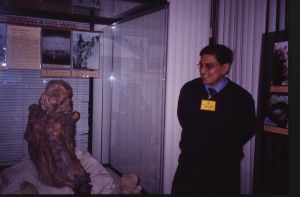The Travels of a Mummy Expert
by Heather Pringle
August 28, 2009
 As a rule, I feel enormously wistful here in Vancouver as the month of September begins to loom.  The long lazy evenings of summer are over, the leaves on the trees are increasingly brittle and brown, and the hummingbirds that darted and threaded through our garden all summer have deserted us for warmer climates. Suddenly, I am reminded of the long rainy winter ahead.
As a rule, I feel enormously wistful here in Vancouver as the month of September begins to loom.  The long lazy evenings of summer are over, the leaves on the trees are increasingly brittle and brown, and the hummingbirds that darted and threaded through our garden all summer have deserted us for warmer climates. Suddenly, I am reminded of the long rainy winter ahead.
This year, however, I have been spared all that late August funk, thanks to the visit of Peruvian mummy expert Guido Lombardi, who has stayed with us on his way back from Asia. For nearly a month, Lombardi has travelled through India and China, guided by an intense, educated curiosity about the many cultures and the intricate ways in which they treat their dead. And almost from the moment I picked him up in the Vancouver airport, he has regaled me with curious stories of Chinese mummies, Tibetan sky burials, and Hindu funerary customs.
I first met Lombardi more than a decade ago in Chile at a very unusual scientific conference—the Third World Congress on Mummy Studies. I spent a week there as a journalist, hanging out with 100 or so of the world’s mummy experts and listening to them talk about their research.  It was enormous fun, and what I discovered is that nearly all mummy researchers are gainfully employed with other day jobs, working as pathologists, neurologists,  parasitologists, botanists, philosophy instructors,  and the like. The ancient dead are a private passion, something they study in their spare time.
Guido Lombardi is no exception to this rule. As a doctor in Lima, he spends his days tending to the ailments of his many patients.  But in his free hours, Lombardi examines and documents mummies—which abound in the arid coastal desert of Peru. And each August, he travels somewhere new, often on a particular personal quest relating to the dead.  He once travelled to the Hague in the Netherlands, for example, just to see Rembrandt’s painting The Anatomy Lesson of Dr. Nicolaes Tulp. The famous work of art portrays a pallid corpse stretched out upon a wooden table and Dr. Tulp, scalpel in hand, demonstrating the fine art of dissecting of a human forearm. Lombardi was so eager to see The Anatomy Lesson that he arrived at the gallery long before it opened at ten in the morning.  He had, he explained to me with a smile, “become obsessed with that painting.â€
This summer, Lombardi travelled extensively in Asia. He wanted to see a very famous Chinese mummy, the Marquise of Tai, which archaeologists unearthed nearly 30 years ago from a massive burial mound near Changsha.  Some people say that the Marquise, who lived around 100 B.C., is the best preserved mummy in the world. She was reputedly sealed in a solution containing mercury salts, and Lombardi wanted to see the body for himself. But when he told a Chinese official that he hoped to travel to Changsha, the official was stunned. Western tourists rarely ever ask to go there.
I have spent the past two days listening to tales from Lombardi’s journeys. He is an excellent story teller and perhaps an even better traveler. In Lhasa, he had a long, detailed conversation with his Tibetan guide about the traditional practice of sky burial – in which the bodies of the dead are exposed to birds of prey. The Tibetans of Lhasa, Lombardi explained to me, took their dead to one of four special stone platforms in the mountains for a traditional funeral. There, as family members looked on, a specialist prepared the corpse for the birds—eagles apparently, not vultures, as is sometimes suggested.  The specialist made a barley paste and placed it in a cruciform incision in the cadaver’s abdominal cavity. He then called to the leader of the birds, who fed first. When the leader had finished, the other birds descended on the body. The whole process was remarkably swift, no more than ten minutes, and family memberts observed it all, said the guide, without distress.  Local belief has it that the birds go straight to heaven when they die.
I took Lombardi early this morning to the airport, and I was sorry to see him go. Emails are a poor substitute for long, late-summer-night conversations.
I would like to thank all the readers of this blog for the hundreds of comments they have posted over the past 14 months or so. Starting next week, I am turning over this blog to Mark Rose, Archaeology Magazine’s erudite executive online editor,  who filled in so admirably for me while I was travelling in South America.  Readers interested in following my work are invited to check out my personal website at www.heatherpringle.com .
Comments posted here do not represent the views or policies of the Archaeological Institute of America.






 Heather Pringle is a freelance science journalist who has been writing about archaeology for more than 20 years. She is the author of Master Plan: Himmler's Scholars and the Holocaust and The Mummy Congress: Science, Obsession, and the Everlasting Dead. For more about Heather, see our
Heather Pringle is a freelance science journalist who has been writing about archaeology for more than 20 years. She is the author of Master Plan: Himmler's Scholars and the Holocaust and The Mummy Congress: Science, Obsession, and the Everlasting Dead. For more about Heather, see our 



